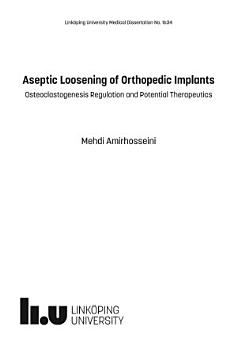Aseptic Loosening of Orthopedic Implants: Osteoclastogenesis Regulation and Potential Therapeutics
About this ebook
In the first study, global gene expression changes induced by mechanical instability of implants, and by titanium particles were compared in a validated rat model for aseptic loosening. Microarray analysis showed that similar signaling pathways and gene expression patterns are involved in particle- and instability-induced periprosthetic osteolysis with an early onset innate immune response as a hallmark of osteolysis induced by mechanical instability.
Further, effects of potential therapeutics on restriction of excessive osteoclast differentiation were evaluated. Wnt signaling pathway is known to regulate bone remodeling. In the second study, effects of inactivation of glycogen synthase kinase 3 beta (GSK-3?), a negative regulator of canonical Wnt signaling, on instability-induced periprosthetic osteolysis were examined using our rat model for aseptic loosening. Inhibition of GSK-3? led to a decrease in osteoclast numbers in the periprosthetic bone tissue exposed to mechanical instability while osteoblast perimeter showed an increase. This was accompanied by higher bone volume fraction (BV/TV) in animals treated with the GSK-3? inhibitor.
In the third study, potential beneficial effects of two selective inhibitors of cyclindependent kinase 8/19 (CDK8/19) on bone tissue were evaluated. CDK8/19 is a Mediator complex-associated transcriptional regulator involved in several signaling pathways. CDK8/19 inhibitors, mainly under investigation as treatments for tumors, are reported to enhance osteoblast differentiation and bone formation. We show in this study, for the first time, that inhibition of CDK8/19 led to marked suppression of osteoclast differentiation from bone marrow macrophages in vitro through disruption of the RANK signaling. In mouse primary osteoblasts downregulation of osteopontin mRNA, a negative regulator of mineralization, together with increased alkaline phosphatase activity and calcium deposition indicated that osteoblast mineralization was promoted by CDK8/19 inhibition. Moreover, local administration of a CDK8/19 inhibitor promoted cancellous bone regeneration in a rat model for bone healing.
These studies contribute to better understanding of mechanisms behind mechanical instability-induced periprosthetic osteolysis and propose potential therapeutics to restrict bone loss with effects on both osteoclasts and osteoblasts.




